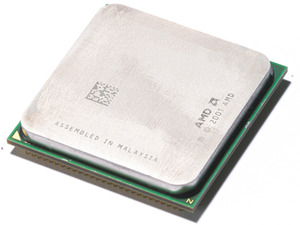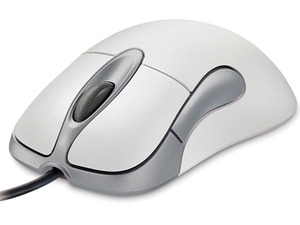
AMD Opteron 144
Launched Summer, 2005Inducted for Demonstrating non-consumer CPUs can be worth a look
Hardware enthusiasts have long known that the best approach to buying a bargain is to look for CPUs at the lower end of the range and overclock them – we regularly post articles to help you do just this, with the last being How to Overclock Intel's Core i5-750 CPU. While we’re accustomed to scrutinising consumer CPUs, every now and then an even better bargain presents itself, wearing the dull branding of a server or mobile chip. The Opteron 144 is the example par excellence of this. Despite being sold as a server CPU, it used standard Socket 939 packaging and was happy to run with regular DDR memory, which meant that you could easily drop it into a killer overclocking motherboard.
When used at its prescribed, factory default settings, it was a cheap and rather bland little chip, running at a mild-mannered 1.8GHz, but when overclocked, it rocked harder than The Mighty Thor in the Motorhead mosh-pit. Models with the best stepping (CABNE) could be overclocked to close to 3GHz on air – which is no mean feat given that, at the time, even AMD’s Athlon 64 FX-57 ran at 2.8GHz.
As Intel was still flogging the dead horse that was the NetBurst architecture, with hot-running, hopelessly inefficient Pentium 4s, an overclocked Opteron 144 was one of the fastest CPUs available. Its only weak point was that it was a single-core CPU, but at the end of 2005, you could pick up one for around £90. No wonder our sister mag Custom PC called it the best overclocker’s CPU ever made.


Left: The Opteron 144, a stunning overclocker; Right: Microsoft's Intellimouse might not be cool, but it is well designed
Intel Core 2 Quad Q6600
Launched End of 2006Inducted for Making choosing a CPU really easy for nearly two years
For a CPU that was the default answer to ‘which chip should I buy?’ from mid-2007 until earlier on this year, the Core 2 Quad Q6600 made a low-key debut. The Q6600 was a quad-core, 2.4GHz processor that cost nearly £600. They were hard to recommend outright at launch - but that soon changed. Within five months, the price was down to £300, and Intel followed this by replacing the original B3 stepping with the justifiably legendary G0. It ran cooler than the original, allowed Intel to almost halve the price again to £170, and it could be easily overclocked to 3.6GHz using basic air cooling. Even the Core 2 Extreme of the time, the QX6850, could only manage 3.8GHz or so when overclocked, and it was hugely more expensive.
Choosing a CPU is usually a complex business, a matter of weighing up the pros and deciding if you can accept the cons. The Q6600 rode roughshod over these conventions, and neatly solved the problem that had previously afflicted quad-core CPUs – that they lacked the outright pace to excel in single-threaded applications. No CPU since has dominated the marketplace to such as extent.
Microsoft Intellimouse Optical
Launched 2000Inducted for Raising the bar for input devices
You have occasion to write some strange sentences working as a hardware journalist and while "this is a classic mouse" isn’t the weirdest (that would probably be "the USB Ghost Radar can detect heat, light, electromagnetic radiation and, of course, ghosts"), it’s certainly in the top ten. Still, it’s a line that says exactly what needs to be said about Microsoft’s Intellimouse.
Considering that Microsoft is more than capable of making crappy, bloated software, it’s surprising that its hardware – and mice in particular – tend to be elegant, refined and work beautifully. Conversely, Apple always makes such terrible mice that it makes you wonder what sort of hands the people in Cupertino have.
Mouse design has evolved over the past decade, but it’s been more like the kind of evolution you’d expect if radioactive waste has been involved – does anyone really need a mouse that has its own weights? A mouse that’s more sensitive than a teenager at a wedding? Or one that costs more than £100?
The Intellimouse has the features you need – an optical sensor, a scroll wheel, easily accessible side-mounted thumb buttons – and
it had these years ago. Ergonomically, there’s little about which to complain too – for an ambidextrous design, the Intellimouse is remarkably comfortable to use.
Of course, we're not saying the Intellimouse is currently the best mouse out there - you can read our recent round-up of the best gaming mice for our thoughts on more current models - but it's important. Microsoft’s products are so widely used that, for many users, they’re the definition of computing. In the case of Internet Explorer 6.0, for instance, this is a bad thing, as it gives the majority of users a poor experience of the Web. The Intellimouse Optical is the opposite; it’s the standard mouse used in schools, libraries and many workplaces. It’s comfortable, approachable and functional, and unlike flashier, more conceptual mice that call attention to themselves with all their flares and scoops, the Intellimouse is completely unassuming – but feels no less natural in the hand for it.

MSI MPG Velox 100R Chassis Review
October 14 2021 | 15:04








Want to comment? Please log in.